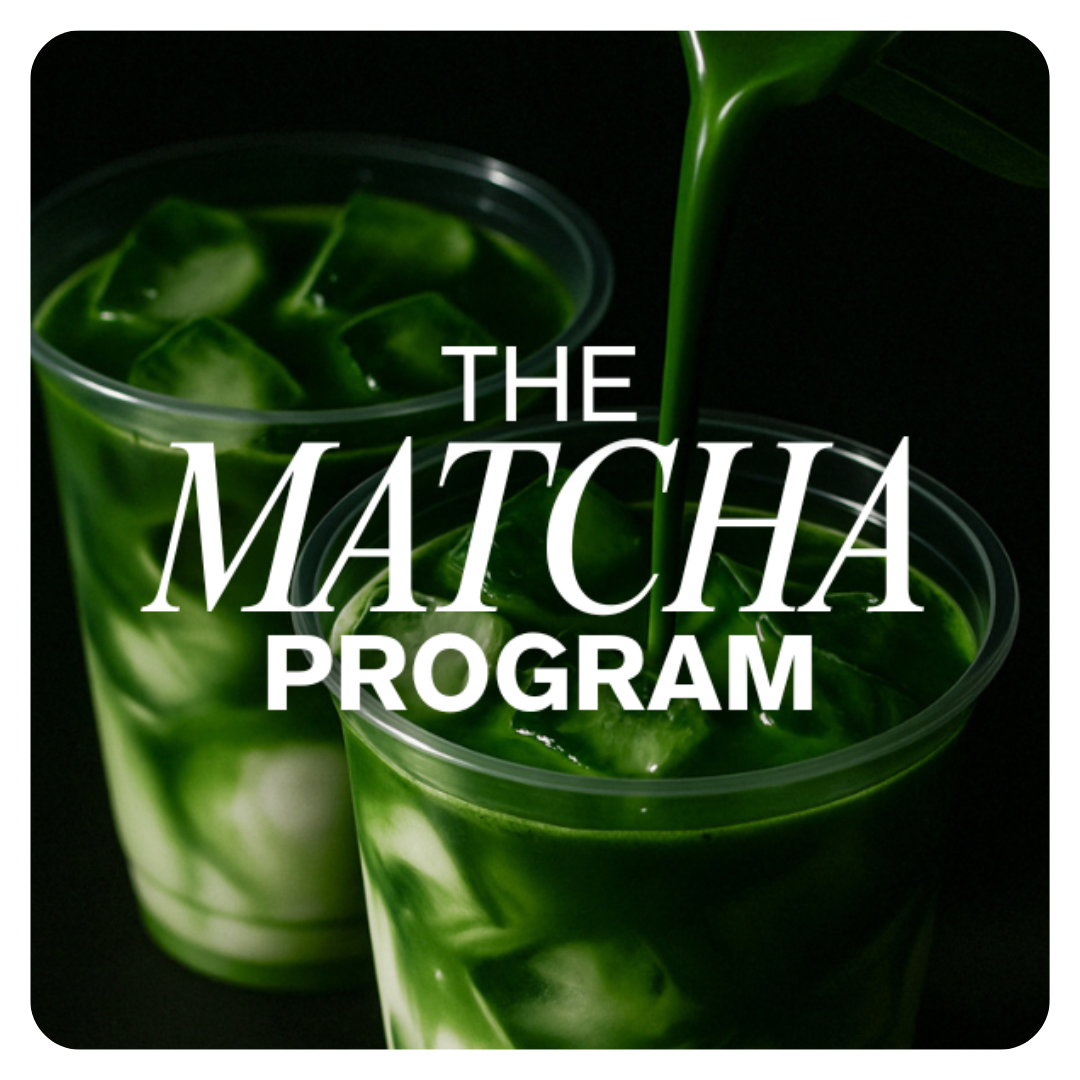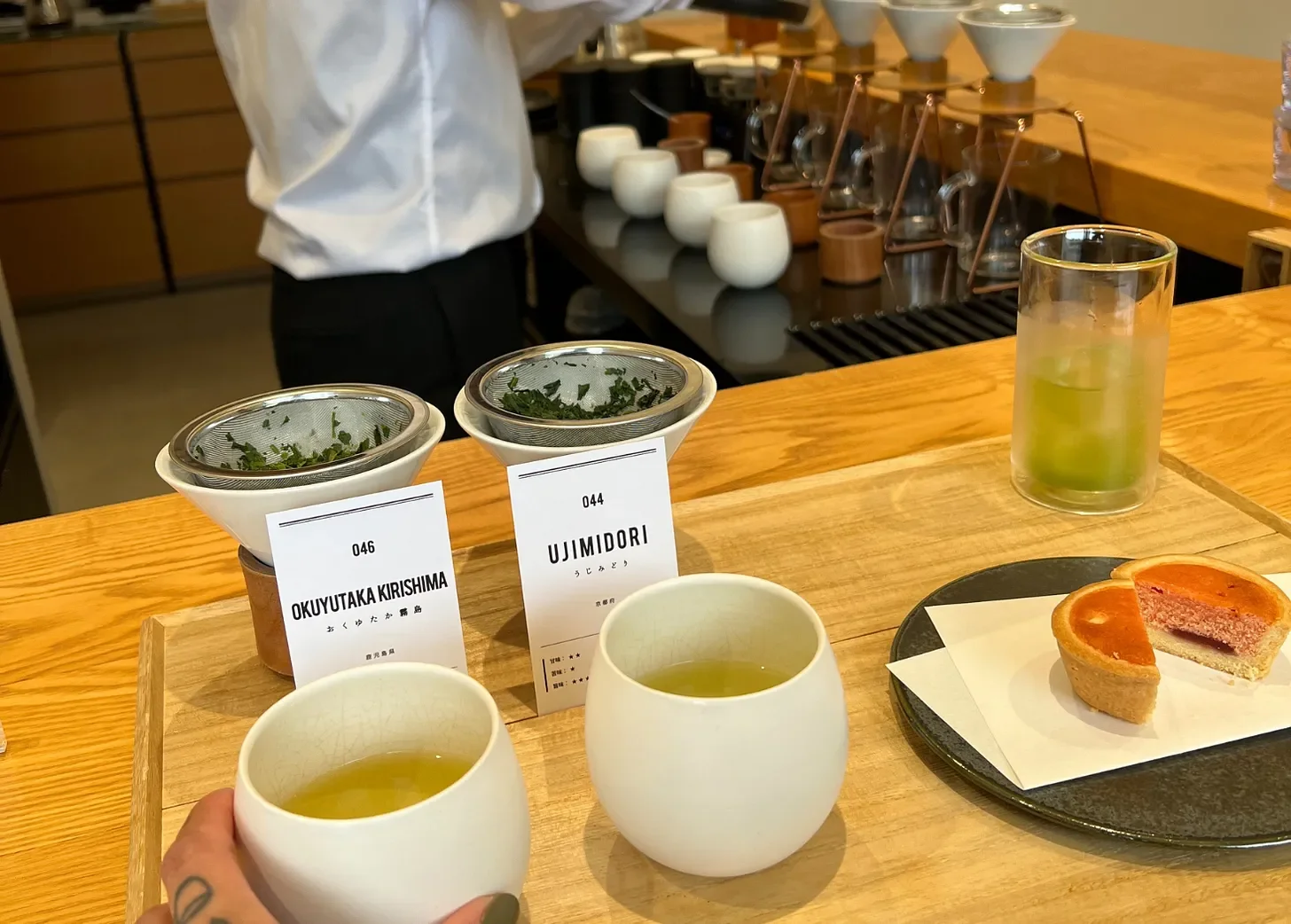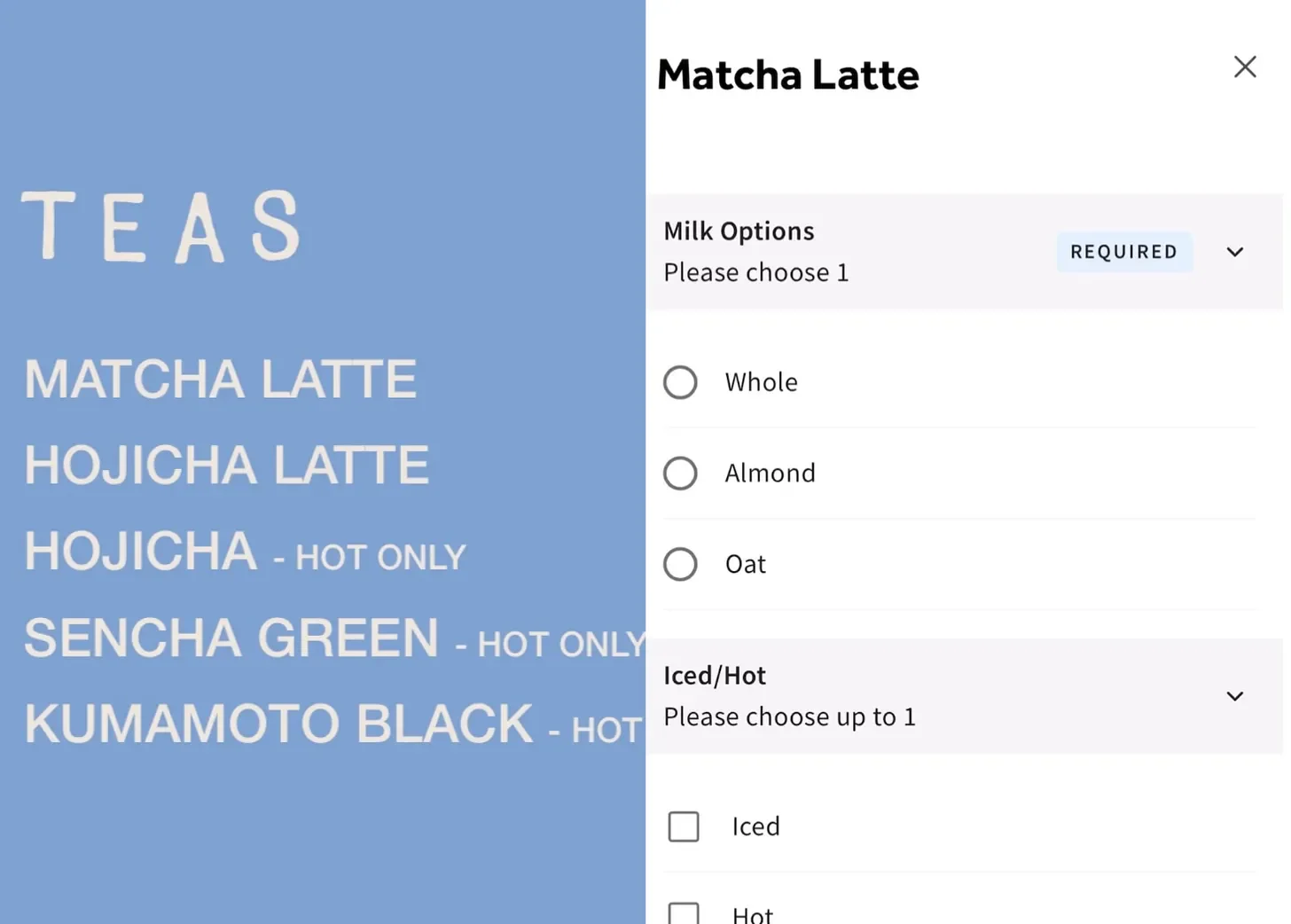Matcha Menu Design and Storytelling
How your menu communicates quality, care, and intention
TL;DR for Busy Operators
Your menu is one of the most powerful storytelling tools in your cafe. How you present, prepare, and communicate your matcha program signals quality, care, and intention to your customers. Beyond the product itself, storytelling builds trust, enhances perceived value, and justifies premium pricing.
Key takeaways:
Matcha menus often lack context—use storytelling to differentiate.
Combine batching and hand-whisking for both efficiency and experience.
Leverage menu design, signage, and social media to share your sourcing story.
Build closer feedback loops between marketing, operations, and leadership to stay current on trends and opportunities.
The story behind your menu
In specialty coffee, storytelling is everywhere. Coffee programs proudly highlight origin, process, and tasting notes, helping customers feel connected to their cup. Matcha programs in busy cafes that also manage a coffee program, however, often overlook this layer. Many menus simply list “Iced Matcha Latte” or “Strawberry Matcha Latte with Cream Top” without any context or identity.
Your broader matcha program is a reflection of your cafe’s quality, care, and attention. Every decision, from how your menu reads to how your matcha is stored, prepared, and presented, tells a story about your values. This is your opportunity to educate customers, build trust through transparency, and justify premium pricing through perceived quality and care.
Why storytelling matters
Humans are wired for stories. Studies from the Center for Neuroeconomics at Claremont Graduate University show that emotionally engaging narratives trigger oxytocin, the “trust hormone,” which deepens empathy and connection.
(Source: Zak, P. (2015). Why Inspiring Stories Make Us React: The Neuroscience of Narrative)
When you share the story of your matcha—its origin(s), cultivar(s), or why you prepare it a certain way—you’re doing more than educating; you’re creating emotional resonance. Storytelling builds trust and trust builds perceived quality. The result is a more meaningful customer experience and a higher willingness to pay for it.
Designing your matcha menu
If you manage both coffee and matcha programs, your menu will naturally be more extensive than a coffee-only cafe. Menu design should balance efficiency, clarity, and storytelling—each element shaping how customers perceive quality and care.
Structure Suggestions
Group drinks by category: Coffee, Matcha, Tea, Seasonal, Signature.
Highlight preparation methods: Hand-Whisked, Batched, both or another method.
If you batch matcha, you already know that while it’s an efficient and scalable system, it’s often misunderstood and stigmatized. Adding a brief note on your menu explaining how and why you batch can help reframe it as an intentional, quality-driven choice rather than a shortcut. This transparency demonstrates care, showing that you have systems in place to slow oxidation, maintain freshness, and deliver consistency across drinks.
Include tasting notes, harvest date, origin(s), cultivar(s), unique cultivation methods—just to name several ideas—on key drinks to communicate quality and traceability. Small details like these help your customers understand and appreciate what they’re drinking—while reinforcing your program’s credibility.
Look to specialty coffee programs and dedicated teahouses for inspiration. You may not be able to go as deep in your storytelling, but there are valuable takeaways in how they communicate craft and process. While printed menus may take more effort to update, digital screens, menu boards, and POS systems for online ordering can be easily refreshed to reflect new drinks, harvests, or notes—keeping your story current without extra friction.
Auditing your current matcha menu
If your cafe has an extensive matcha menu, it’s worth auditing your current offerings at least twice a year to ensure they’re still aligned with customer preferences, profitability, and emerging trends.
Leverage your POS data to identify both your top-performing and bottom-performing drinks over the last six months. Patterns here can reveal a lot about what resonates with your audience and where your menu might be oversaturated or stagnant.
Creating room for innovation is key—especially in an era where new ingredients, textures, and aesthetics often drive social engagement. Phasing out underperforming drinks can free up bandwidth (and menu real estate) for opportunistic trends and new creative spins that keep your program fresh and relevant.
If a drink is beloved by your regulars but underperforms overall, communicate thoughtfully. Announce any menu retirements in advance and frame it as a “last chance to enjoy” moment. This not only honors customer sentiment but also builds anticipation for what’s coming next.
Differentiation ideas
With the rise of community specialty cafes and popups, differentiating yourself is crucial—especially in the age of social media, where novelty can drive foot traffic.
Most matcha menus look similar: iced matcha lattes, cream tops, fruity purees. Go beyond the expected by introducing signature or seasonal drinks that celebrate matcha itself.
If your go-to preparation method is hand-whisking, consider expanding your menu to include traditional offerings like usucha (thin tea) or koicha (thick tea). These may not be major sales drivers, but they elevate your brand identity and invite education and exploration.
Think of a matcha shot like an espresso shot—standalone yet versatile. It can be integrated into creative beverages just as espresso is, from spritzes to sparkling tonics or layered signature drinks.
💡 Tip: If you have an in-house social media manager, ensure they are reporting weekly trends and insights to leadership. What matcha drinks are trending? What ingredients are complementary to matcha? What are popular cafes throughout the US and globally doing?
While “going viral” should not be the sole reason to develop creative matcha drinks, it is an opportunity to leverage free attention on social media to promote your cafe. Matcha lovers often bookmark or save content for future travel, and a single well-crafted drink can bring new customers through your door.
Balancing hand-whisking and batching
Both can coexist beautifully when supported by strong systems and staff training.
Batching improves speed, consistency, and scalability, especially when most drinks are iced matcha lattes.
Hand-whisking adds craftsmanship and ritual to your program, perfect for cafes with slow-bar setups or customers who appreciate mindfulness in preparation.
An incredible Japanese tea “slow bar” concept in Japan centered around storytelling and appreciating nuance in each offering.
If you already offer pour-overs, consider a mirrored “slow bar” for matcha if you have the operations to support it. It creates an intentional space to highlight preparation, foster conversation, and educate customers on matcha’s flavor nuances, which are often masked in milk-based drinks.
This can also work if you offer multiple matcha offerings (blends, single cultivars, single origins). A tasting flight or side-by-side comparison of koicha and usucha can help customers understand the artistry and complexity behind the tea.
Note: For this concept, where matcha is prepared and enjoyed traditionally, source high-quality first-harvest matcha intended for both formats. While any matcha can technically be made into koicha, it doesn’t mean it should.
For more on batching myths, misconceptions, and best practices, see our previous post here.
Storytelling through your menu, signage, and social media
Example of how a cafe communicates its matcha offering across digital and printed menus. While the cafe uses a high-end matcha vendor, the online ordering system lacks the same storytelling and detail. This is an easy opportunity to elevate perceived quality—updating copy takes minutes but can meaningfully enhance customer perception.
Your menu, digital boards, printed collateral, and social media can all serve as storytelling mediums. Include details such as:
Harvest season or milling date
Region(s) and cultivar(s)
Tasting notes and preparation style
If you work with a reputable matcha supplier, this information should be accessible through their wholesale team or website. If not, ask. Transparency should be part of every partnership.
It’s worth noting that not all tea producers or farmers wish to be publicly named or photographed. If privacy is requested, storytelling can still thrive through terroir descriptions, processing details, or flavor journeys rather than individual names.
Co-branding opportunities
If you feature a well-known matcha brand, including their name or logo on your menu, digital screens, or in-store signage can build trust and recognition. This creates a brand halo effect that enhances your cafe’s credibility in the eyes of discerning customers.
For cafes with strong visibility or social traction, co-branding can open doors to partnership support—negotiated wholesale rates, marketing collaborations, or social amplification. It can also lead to cross-promotion, where your matcha supplier shares your content to boost reach.
Conversely, not every premium matcha partnership delivers proportional value. Some cafes have seen minimal impact from promoting high-priced matcha despite the elevated wholesale cost. Reflect on whether your supplier relationship feels mutually beneficial. If it does not, consider exploring sourcing options that maintain your quality while improving margins.
Leveraging supplier resources
Many matcha brands with wholesale programs, especially those founded outside Japan, offer barista training, recipe guides, and marketing assets. If you have not tapped into these, request access.
If you source directly from Japanese producers or teahouses, such materials may not exist. In that case, resources like The Matcha Program can serve as your ongoing education hub.
Next Steps for Operators
✅ Review your current menu design. What opportunities exist to incorporate storytelling? Could your menu better communicate quality, care, and transparency?
✅ Audit your social media strategy. How are you elevating matcha and showing how your brand is different? If you aren’t already doing this, it’s an untapped opportunity to reach more customers and build brand trust.
✅ Seek sourcing information from your wholesale partner. If that information isn’t accessible, question it. It may be time to explore other options.
✅ Establish systems for feedback loops. Connect your social media manager, cafe manager, and leadership team so insights and trends are regularly shared. Staying agile keeps your brand relevant.
💬 We Want to Hear From You!
Have questions or feedback? Drop them in the comments below.
If there’s something you think we should address or expand on, let us know—we love learning from you.
A Note of Gratitude
We launched The Matcha Program just three weeks ago and have been deeply encouraged by the enthusiasm and support for our content. While there’s no shortage of matcha information online, we saw an opportunity to fill a gap—to resource cafe operators and baristas who serve as many customers’ first touchpoint with matcha.
We’re energized by this growing community of operators, baristas, and enthusiasts who’ve taken the time to subscribe to our Substack and follow our journey on Instagram and TikTok. Your engagement fuels our commitment to making matcha education more relevant, approachable, and actionable for the people bringing it to life every day.





